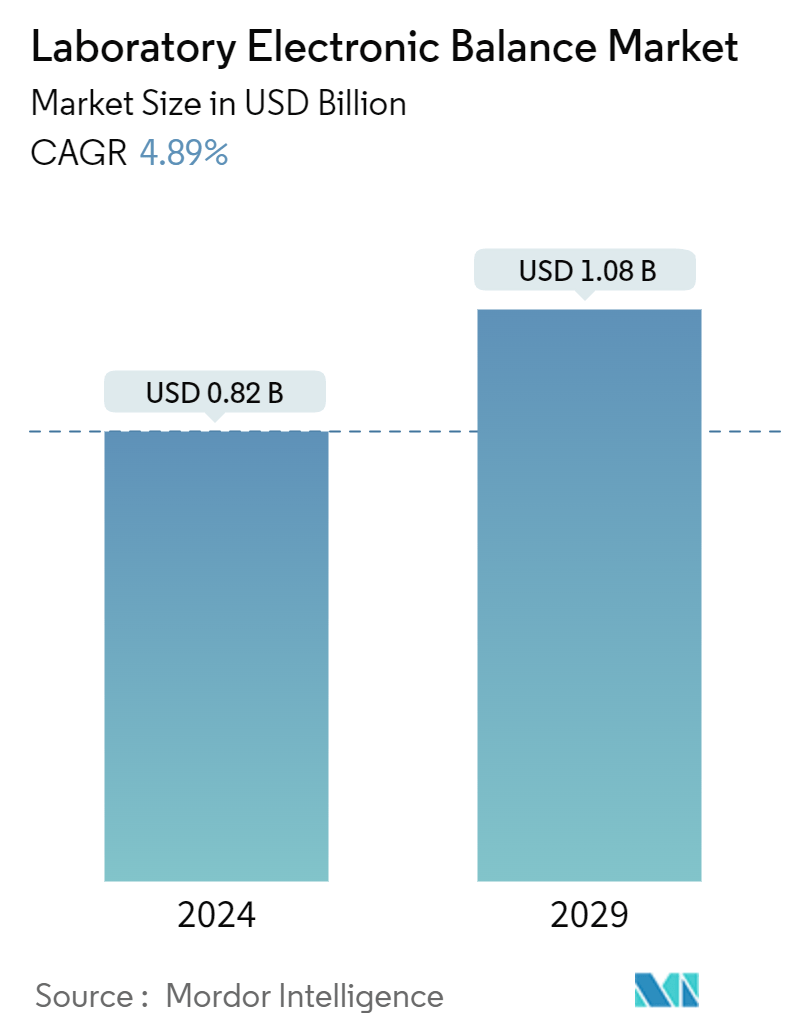Market Size of Laboratory Electronic Balance Industry

| Study Period | 2019 - 2029 |
| Market Size (2024) | USD 0.82 Billion |
| Market Size (2029) | USD 1.08 Billion |
| CAGR (2024 - 2029) | 4.89 % |
| Fastest Growing Market | Asia Pacific |
| Largest Market | North America |
| Market Concentration | Medium |
Major Players
*Disclaimer: Major Players sorted in no particular order |
Laboratory Electronic Balance Market Analysis
The Laboratory Electronic Balance Market size is estimated at USD 0.82 billion in 2024, and is expected to reach USD 1.08 billion by 2029, growing at a CAGR of 4.89% during the forecast period (2024-2029).
- The increasing demand for accurate and reliable measurements is a significant driver in the laboratory electronic balance market. This demand impacts industries that rely on precision for quality, efficiency, and compliance, including scientific research, manufacturing, and pharmaceuticals. For instance, even the slightest variance in drug ingredients can lead to ineffective or unsafe products in the pharmaceutical industry, forcing the industry to use laboratory electronic balances to weigh active pharmaceutical ingredients (APIs) accurately.
- Moreover, industries such as pharmaceuticals, food and beverages, and chemicals face stringent regulations like GMP, FDA, and ISO. These industries rely heavily on precise weighing to ensure product safety, accurate labeling, and regulatory compliance, thereby boosting the demand for trustworthy electronic balances.
- Further, emerging technologies, notably artificial intelligence (AI) and the Internet of Things (IoT), are reshaping the laboratory electronic balance market. Electronic balances, now AI-powered and equipped with machine learning algorithms, can analyze weighing data in real-time, discern patterns, and fine-tune measurement parameters, thereby boosting accuracy and efficiency. Meanwhile, IoT-enabled balances facilitate communication with other laboratory equipment and systems, paving the way for integrated and automated laboratory workflows. Such advancements promise to revolutionize precision weighing and spur innovation within the laboratory electronic balance market.
- Laboratory electronic balances must undergo regular calibration to maintain accuracy. In environments demanding high precision, these balances might require calibration several times daily, particularly when faced with fluctuating environmental conditions like temperature or humidity. Such frequent calibrations can be time-consuming and may disrupt the laboratory's workflow.
- Macroeconomic factors, such as inflation, drive up the cost of raw materials for manufacturing electronic balances. Consequently, this surge in production costs often gets transferred to consumers, rendering these balances pricier. Furthermore, as the cost of these products escalates, demand dwindles, particularly in budget-constrained laboratories, notably in academia and the public sector.

